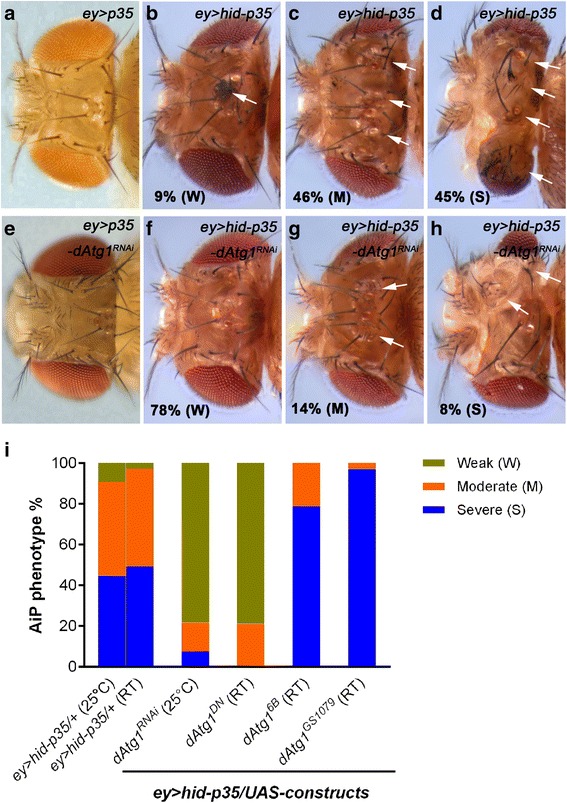Fig. 1.

Suppression of ey > hid-p35 by loss of dAtg1. The hyperplastic overgrowth phenotype of ey > hid-p35 can be grouped in three categories, weak (W, including wildtype-like), moderate (M) and severe (S), as previously described [52]. Moderate flies are characterized by overgrowth of head capsules with duplications of bristles (arrows) and ocelli (arrowhead), while severe flies have overgrown and deformed heads with amorphic tissue. Each screen analysis was repeated at least twice with scoring more than 50 ey > hid-p35/(RNAi or mutant) adult flies. a–h Representative dorsal views of adult fly head capsules of the indicated genotypes. a–d Compared to the control ey > p35, which is similar to wildtype (a), percentages of ey > hid-p35 flies display weak (b), moderate (c) and severe (d) phenotypes (9 %, 46 %, and 45 %, respectively). Therefore, over 90 % of ey > hid-p35 flies show a clear hyperplastic overgrowth phenotype (either severe or moderate). e Knockdown of dAtg1 by RNAi in ey > p35 does not cause obvious defects on head capsules. f–h dAtg1 RNAi strongly reduces the percentage of ey > hid-p35 flies showing severe (8 %) and moderate (14 %) overgrowth phenotype and largely extends the population of flies with a weak or wildtype-like appearance (78 %). i Summary of the suppression of the ey > hid-p35 overgrowth phenotype by expressing dAtg1 RNAi or dominant-negative dAtg1 DN and the enhancement of the phenotype by expressing two constructs encoding dAtg1 (dAtg1 6B and dAtg1 GS1079). Either 25 °C or room temperature (RT, 22 °C) was used for these analyses. The majority of ey > hid-p35 flies (ey > hid-p35/+) display either severe or moderate overgrowth phenotypes at both 25 °C and RT. Blue indicates severe, orange indicates moderate, and green indicates weak or wildtype-like phenotypes
